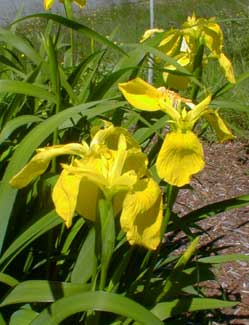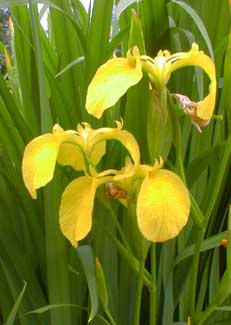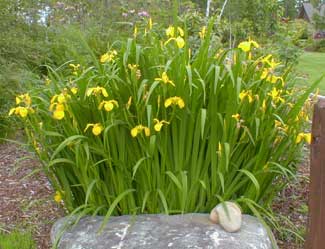
Wild Yellow Iris
"Thou art the Iris, fair among the fairest,
Who, armed with golden rod
And winged with the celestial azure, bearest
The message of some God."
-Henry Wadsworth Longfellow
(1807-1882)
(1807-1882)
 The wild yellow iris (I. pseudacorus) has been called "Queen of the Swamp." It is not originally native of North America, where no bright yellow iris is actually indigenous. But it has naturalized throughout the majority of American states & much of Canada, although lacking in the Dakotas & in the Rockies. In some states it is regarded as an invasive pest plant, beautiful though it happens to be.
The wild yellow iris (I. pseudacorus) has been called "Queen of the Swamp." It is not originally native of North America, where no bright yellow iris is actually indigenous. But it has naturalized throughout the majority of American states & much of Canada, although lacking in the Dakotas & in the Rockies. In some states it is regarded as an invasive pest plant, beautiful though it happens to be.It originated in the British Isles & Europe, but was transported around the world by gardeners in the early 1900s. It escaped to the wild just about everywhere that is wet enough & generally temperate. It established itself in New Foundland by 1911, in British Columbia by 1931, & by 1950 it was growing wild everywhere from Newfoundland to Minnesota.
It was first reported in California in 1957, when one river was already so clogged with yellow iris that native plant life had been entirely squeezed out. In 1958 it was discovered to be very common in Montana's Ninepipes National Waterfowl Refuge, its enormous grassy blades so dense that waterfowl could neither swim through nor nest amidst it. It has simply proven to be one of the most aggressively self-seeding rapidly-spreading irises anywhere in the world.
Your ol' ratgirl given her age is really more of a rat-hag, as I'm old enough to remember as a child that this was a "new" weed along the waterways of Western Washington. And just about everyone who went camping, fishing, or hiking, encountering this beauty in full flower, wouild bring a clump of it home for the garden, thus facilitating its spread. The crazy thing is that even today you can buy it in some nurseries, when by rights it should be banned from nursery distribution but is still legally obtainable.
It is very common all around Puget Sound in wetlands, roadside ditches, often sharing boggy ground with cattails, skunk cabbage, or teasel. When seen in wetlands it is six feet tall. It adjusts to regular watering in garden conditions, but will only be about four feet tall outside of a swamp.
Here in Kitsap County it is way too late to be rid of it, so I'm not adverse to the habit people have of digging up a bit of rhizome from the roadside to put in their gardens, since the county's already invaded to the hilt. It does do some good, in that it removes heavy metals from polluted run-off, thus as a roadside plant is cleaning up surface water. Of course, some of the native plants it has displaced would've done the same, so it's good deed is an awfully thin silver lining.
 In a friend's garden when I've done some landscaping work, someone in the past seems to have dug up a little of it (I assume originally only a little bit) from the nearby wetlands & planted it at the end of a fenceline in a spot that gets good irrigation but certainly isn't boggy.
In a friend's garden when I've done some landscaping work, someone in the past seems to have dug up a little of it (I assume originally only a little bit) from the nearby wetlands & planted it at the end of a fenceline in a spot that gets good irrigation but certainly isn't boggy.When I first saw the patch, it had spread both by rhizomes & seeds to a five foot wide dense patch of iris grass that blooms briefly mid to late May. Four years later it was an eight-foot wide patch & would've been much larger but that efforts have been made to restrain it, & it gets deadheaded before it casts seeds all over heck. I had recommended getting rid of it entirely, but as it grows wild in the nearby watershed it couldn't be argued that it was doing greater harm to keep it, & my chums became too fond of it when it makes such an amazing flowery show.
It produces huge numbers of flat seeds spat from three-sided pods. Tiny seedlings spring up all around the mature patch, easily starting themselves even in the thick layer of woodchip mulch that suppresses weeds pretty well, but doesn't suppress these seedlings. The seeds like to lay on the surface of the mulch & get baked in middle to late summer, then will develop as wee grassy seedlings the next year by late spring.
If not controlled, this plant would spread & spread until it became a thicket displacing every perennial in its path, so I've at least convinced the proud owners of this patch to deadhead religiously so as not to be fighting against hundreds & hundreds of seedlings.
Despite that it is a bog plant that adapts to moderate watering in gardens, it happens also to be drought tolerant. It doesn't look pretty in droughty conditions, but it could completely dry out for three months, & as soon as water returned it would spring up with its lively grass.
It's ideal habitat in the wild is seasonally dried out for the sake of baking the seeds before they will germinate. If used as a pond plant with a perpetual depth of mud or water, it will not seed as well as it will on land with a dried-out period, but it will spread its rhizomes even more quickly & if not weeded down from time to time could displace everything else in the pond.
As a garden flower, it has very high nitrogen needs, such as would be provided by a seasonally muddy environment with lots of duck poo. It may become less flowerful if not fertilized once a year. The rhizomitous spread seems not to be effected either way, though.
 The wild yellow iris is probably the first iris ever called "fleur de Lys," fleur de lis, or Fleur de Luce. Because it became the heraldic symbol of the French Courts, it has long been assumed Lys or Luce is a corruption of Louis, under the assumption that the symbol acquired this name only after the gold flower was used by Louis VII (1180-1214) as an emblem of the royal house. But it was actually first used by his grandfather Philip I (1052-1108).
The wild yellow iris is probably the first iris ever called "fleur de Lys," fleur de lis, or Fleur de Luce. Because it became the heraldic symbol of the French Courts, it has long been assumed Lys or Luce is a corruption of Louis, under the assumption that the symbol acquired this name only after the gold flower was used by Louis VII (1180-1214) as an emblem of the royal house. But it was actually first used by his grandfather Philip I (1052-1108).A later myth (perhaps dating to the 14th Century) became attached to the emblem to suggest that its three-part design meant that the French kings descended from Jesus through his wife Mary of Bethany (combined in French legends with Mary Magdalene). This iris was retroactively said to have been a symbol of Clovis I king of the Franks (466‚511) & whose name was Gallicized as Louis. Clovis was said to have worn the yellow iris in his helmet to enter into battle against Rome, & a river of iris grass evoked the upraised swords of the armies that Clovis led.
A better explanation is that fleur de lys was a translation from an old German word for yellow iris, Lieschblume. When rendered into French "blume" became fleur, & "Liesch" becomes Lys. Another elegant explanation is that it was named for the River Lys or Leie which runs through France & Belgium, & where the yellow iris was extremely common.
Among the many other old names for Yellow Iris is Segg, Cegge, Seag, Seggin, Skeggs, Sheggs or Yellow Saggen, from an Anglo-Saxon word meaning "Sword" or "Swords," after the leaves, the same root word as for sedge grass.
For the same reason it has also been known as Daggers & Jacob's Sword, this latter a scriptural reference to Jacob's conquest of the Emorites [Genesis 48:22]. Chaucer knew it as Gladyne which again means "Sword," & is echoed in other sword-leafed plants like Gladiola & the Stinking Gladdon or Gladwyn Iris.
The old folknames Fliggers, Flaggers, Flagflower, or Flaggon allude to the leaves moving with a breeze; so too the still-used as Swamp Flag or Yellow Flag, though "flag" has come to be regarded as an allusion to the blooms themselves. The old folkname Shakier may also allude to the windblown leaves or blossoms.
It has also been known as Laver, Levers or Livers, from an old English word for grassy vegetation (also for seaweed), the same root word for Liverpool which may well allude to irises along the Mersey.
It has also been known as Cheiper, from an obscure term meaning the shrill sound made when an iris leaf is held between the thumbs in such a manner as to blow across it like the reed of a musical instrument. It was called Cucumbers because the seedpod when green was supposed to resemble one. It has many other folk names in English alone, not to mention the variety of names it aquired in other languages.
The seeds have been roasted & ground as a coffee substitute & tonic. The root has been used as an ingredient in black dye, & in powdered form as an ingredient in snuff. It was formerly used as a cathartic or astringent & as a scented detergent or deoderizer for stored linens.
Herblore has made of yellow iris root or the juice thereof a cure for poisoning & snakebite, a remedy for toothache, diarrhoea, cough, headache, cramps, ulcers, rabies, dropsy, & as a topical skin treatment or eyewash despite the risk of causing skin inflammation or injury to the eyes. The primary "active" ingredient for its sundry alleged medical value would be the tannins, which are sufficiently dangerous for most of its dubious uses that for once rationality won out over popular belief, & it is not today so popularly used.